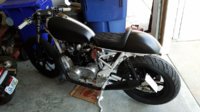Yes on the "sprayer with straw" trick.
You could also try to eliminate the possibility of a crack at the bottom of the inlet tract, by carefully and slowly painting small daubs of grease on the underside of the head, in this area, adjacent to where the inlet tract runs, while it's doing its hi-idle thing.

You could also try to eliminate the possibility of a crack at the bottom of the inlet tract, by carefully and slowly painting small daubs of grease on the underside of the head, in this area, adjacent to where the inlet tract runs, while it's doing its hi-idle thing.
Last edited:

